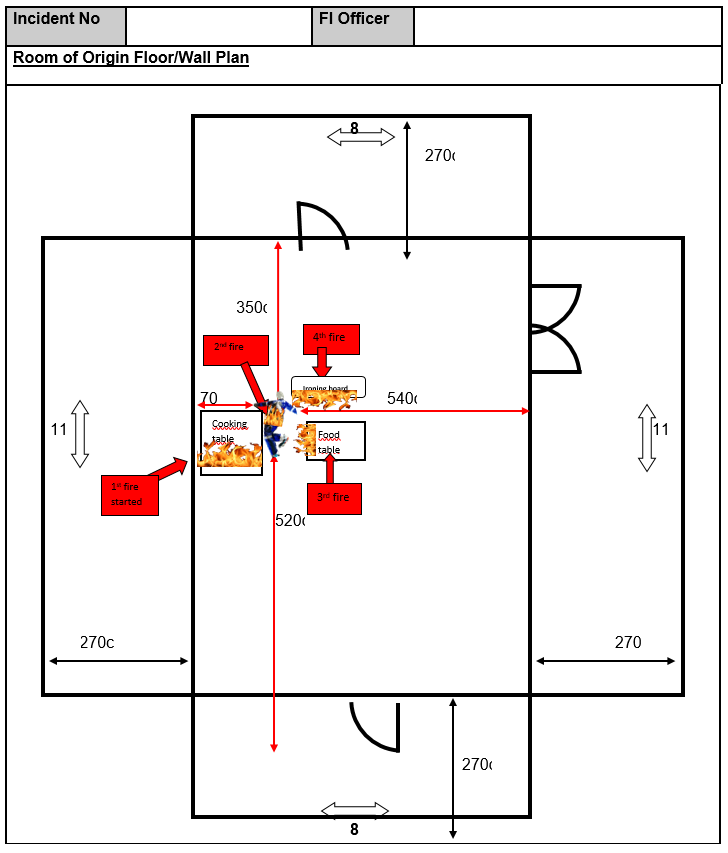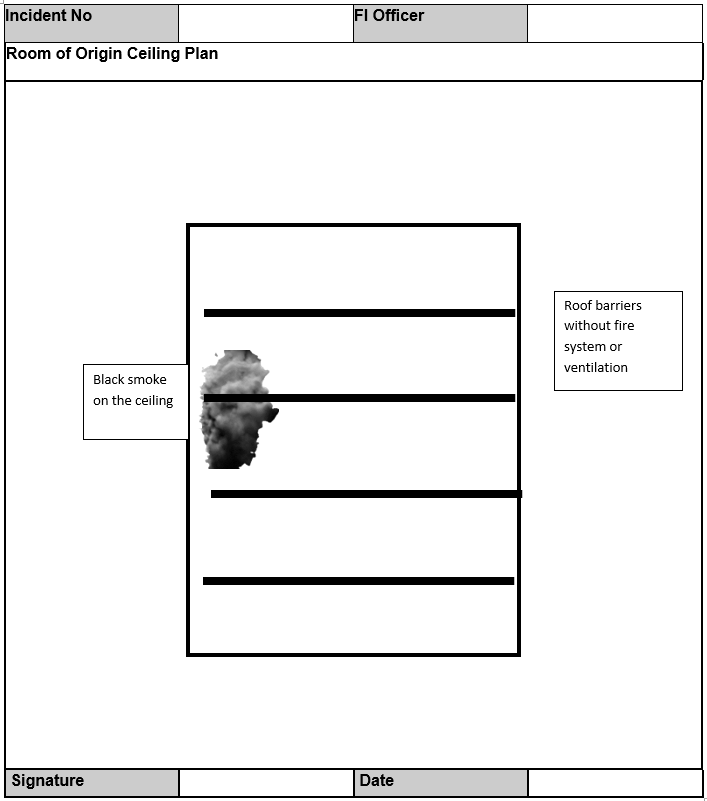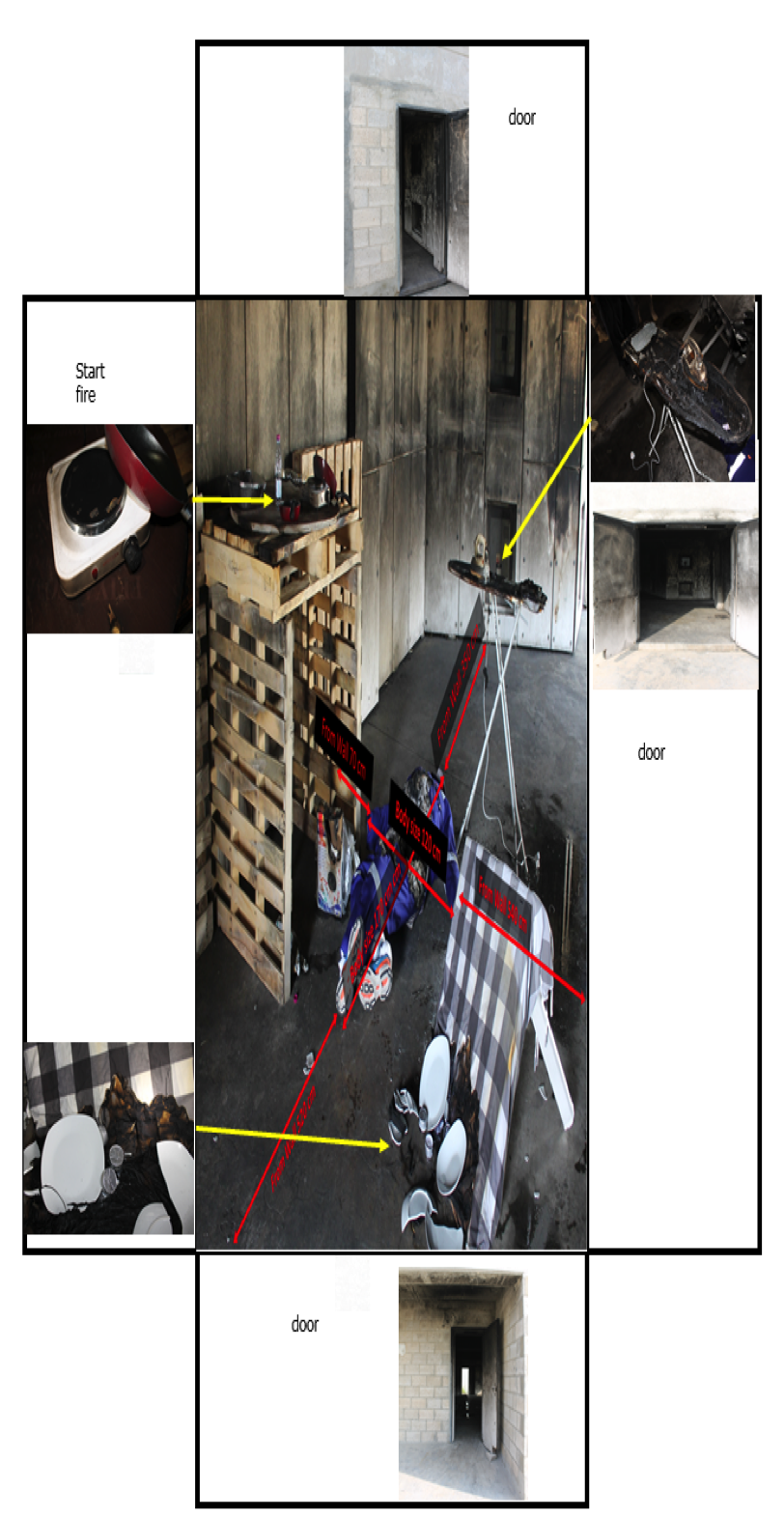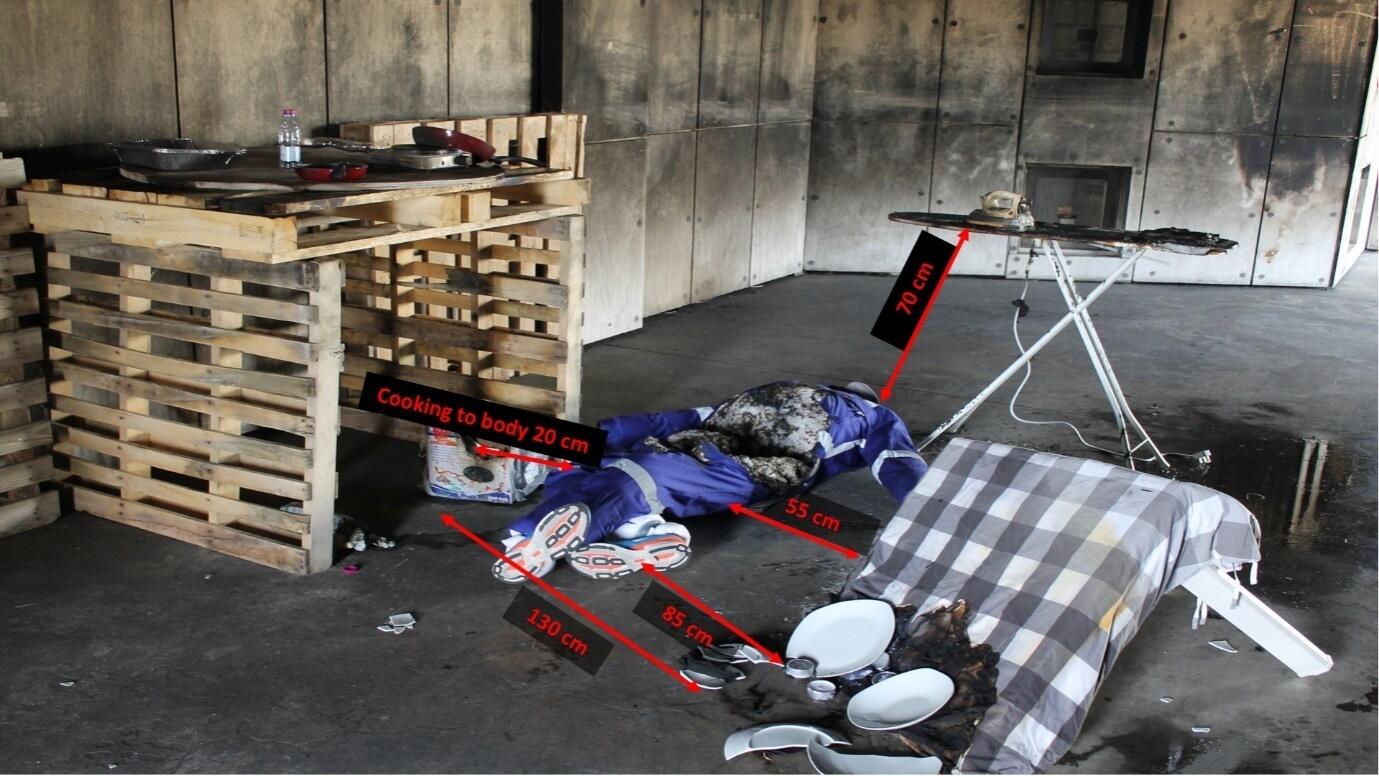Introduction and Curriculum Vitae
I work as a fire investigator for the Lancashire Fire and Rescue Service. I have previously completed my master’s degree in Fire Investigation at the University of Lancashire. After graduation, I took my current position as a fire investigator and have become a member of several professional organisations, including the Institute of Fire Engineers, the International Association of Arson Investigators, and the National Fire Protection Association.
I received the first information about the incident at 9:32 pm on November 27th, 2018 through a phone call from Fire Service Control. I arrived at the scene at 9:40 pm to begin a fire investigation, which commenced at 9:45 pm.
As part of the investigation, I took photographs of the scene. These are referenced in the report and can be found in the appendix section of this document. All comments and opinions included in the report are based on my examination of the scene, as well as on information obtained from witnesses and the facts that were available at the time of report completion. Hence, the report may be amended or extended if new details emerge and the additional information is reliable.
Before beginning a fire investigation, it was critical to address the hazards found during the initial risk assessment. The first hazard was the presence of sharp objects, and I took steps to control the risk by using Personal Protective Equipment (PPE), covering the victim’s injuries, and removing dangerous sharp objects from the scene. PPE was also used to protect from burning ashes and biological hazards.
There was a risk of slipping and tripping, which I addressed by securing the sliding material and removing clutter from the floor. The possibility of a secondary fire of electrical origin was also a concern, and I took steps to isolate open electrical wires and separate all electrical appliances from the system using the mains switch. Adequate ventilation of the scene was ensured to contain the hazards from burning ashes and toxic gasses.
Other precautions were also taken to ensure the reliability of the fire investigation results and prevent any harm to the crew. All members of the team used PPE and moved with caution to the scene of the incident. The scene was protected prior to evidence collection in order to eliminate any threat of tampering. The evidence was obtained by taking notes, photographs, and samples from the scene. The evidence was then analysed to determine possible causes of the fire and scenarios of the incident. The evidence and scenarios were then tested to recreate the most likely course of events before and during the incident. This report was based on an analysis of all information from the scene that was available at the time of completion.
Description of the Premises
The type of dwelling is a semi-detached house with no basement. The external size of the premises is 8 by 11 metres. The interior walls, floors, ceilings, and roof were constructed using concrete, whereas the exterior walls were made from brick. Based on the documents, the approximate date of construction is 2009. The last maintenance was completed about three months prior to the incident. The floor plan of the premises is provided in the appendix section of the report.
The main issue that was identified at the premises is the lack of a suitable fire protection system. There were no smoke alarms or smoke detectors in the house. The fire started in the kitchen area, originating near the oven and spreading to the dining table and the ironing board nearby. No active fire system was found at the scene, which is why the victim could not take necessary measures to extinguish the fire quickly.
Type of Incident
The incident was a domestic fire that originated in the kitchen area located on the ground floor of the premises. The fire did not spread to other rooms or floors and was contained in the kitchen. The incident started while the occupier of the premises (Steven) was cooking. He heated vegetable oil in a frying pan at a high temperature, which caused the oil to burn. As there was no fire extinguishing system in place, Steven attempted to put out the fire with water, but this did not help, as the cause was burning oil. The fire first spread to the garbage can, then to the food table and the ironing board. Steven was burned during the incident and was found dead in the kitchen area when the team arrived.
The police were alerted after receiving a 999 call from a neighbour who saw the fire approximately two minutes after the beginning of the incident. The police passed the information about the fire to the fire department. The team arrived at the scene after eight minutes and included two engines, an ambulance, the police, and a water tanker. I was equipped with all necessary tools to ensure adequate protection while handling the incident and investigating the scene, including PPE and breathing apparatus.
Prehistory
The premises did not have any fire prevention measures, such as fire alarms or smoke detectors. A witness report was collected from the neighbour, who stated that he last saw Steven in the morning on the day of the incident. Steven is the occupier of the apartment and had been living on the premises for 18 months before the event.
Discovery of the Fire
The fire was reported by Mr Paul Naubourl, who is Steven’s neighbour. According to the witness report, Paul saw the smoke coming out of the window of Steven’s apartment and called the police on 999 immediately. Paul said that there was a lot of smoke during the fire, which is also evident from the black smoke residue on the ceiling in the kitchen area. The witness also said that he realised that Steven was still inside the building and that he tried to rescue the victim. At the time of the control team’s arrival, Paul was contacting other people in the neighbourhood in an attempt to save Steven from the scene of the fire. The arrival of the police and the fire service prevented Paul from entering the premises, although he was still examined by medical personnel in the ambulance to confirm the lack of physical injuries.
Area where the Fire Started
As part of the investigation, evidence was collected to determine the area where the fire started. Based on the photographs of the scene, which can be found in the appendix, there was a lot of fire damage in the area near the kitchen. There were also black marks on the kitchen ceiling from the smoke. There was less fire damage in other areas of the premises, which points to the conclusion that the area where the fire started was the kitchen. The most likely source of ignition was burning oil, but it is also possible that the fire started from the iron, the stove, or a candle. The oil in the frying pan most likely started to burn due to the high temperature. The materials that ignited first were therefore the oil in the frying pan and other flammable items in the area next to the stove.
As evident from the photographs of the scene, the fire did not spread beyond the room of origin. Therefore, the fire only affected the victim’s apartment and did not damage the neighbouring premises. The fire spread rapidly due to the presence of flammable materials around the cooking area and the lack of a working active fire system. The victim was also inexperienced in extinguishing fires of different types, which explains why he tried to put out the oil fire with water.
Development of the Fire
The assessment of the scene showed that the origin of the fire was next to the cooking area and that the likely cause of ignition was the cooking oil. Once the frying pan with oil began to burn, there were several factors that contributed to the development of the fire. First, Steven attempted to pour water into the frying pan to extinguish the oil, but his clothes caught fire. Steven fell to the floor, and the fire spread further to the garbage can, the plastic table in the kitchen, and the ironing board. The second factor that assisted in the development of the fire was that the door into the kitchen was left open. This provided extra ventilation, thus contributing to the fire and enabling it to spread to other surfaces in the room, surrounding the victim.
Another apparent reason for the fire development was the high temperature of the frying pan. Apart from causing the oil to ignite, the hot pan also caused the fire to spread to nearby items when the victim put it down on the table. Finally, the fire could have been contained much faster if there were smoke alarms and an active fire system. These would have helped to alert the fire services sooner while also extinguishing the fire quickly and effectively.
Causes Considered
As part of the investigation, several alternative causes of fire were considered. First, smoking cigarettes could have caused the fire in the kitchen area. However, no lighters, cigarettes, or other smoking materials were found in the apartment, and the neighbour said that he had never seen Steve smoking before the incident. Second, the fire could have begun due to an electrical malfunction. Upon examination of the scene, it was found that the victim had a number of electrical appliances and sockets in the kitchen area, some of which were switched on during the incident. As electrical appliances are often a source of secondary fire, they could have also influenced the initial development of the fire in the apartment.
Additionally, the investigation also considered gas defect as a possible cause of the fire. Gas leaks can cause a fire to spread rapidly, and the materials gathered from the scene indicated the quick development of the fire. After examining the scene, I found that no LPG cans or gas supplies were present in the area, and therefore this possible cause appears to be unlikely. Some heating equipment can also cause ignition, which is why heating was considered among the possible causes of the incident.
Nevertheless, the team did not find any heating equipment in the kitchen area. Similarly, there was no paraffin or fuel found on the scene, so it is improbable that these substances contributed to the outbreak of the fire. Finally, arson was considered as part of the investigation process. Upon the team’s arrival at the scene, it was found that the doors into the apartment and the kitchen area were not locked. However, there was no sign of forced entry on the door, and thus it is more plausible that the fire occurred by accident.
Medical Information and Assessment of the Victim
As the fire did not spread to the neighbouring apartments and houses, the only victim of the incident was the occupant of the flat. His name was Steven, and he was a 32-year-old male. Steven was approximately 170 cm tall and weighed around 70 kg. The victim’s body was located at 9:45 pm after the fire has been fully extinguished. The area where the victim was found was the kitchen. The victim was discovered lying on the floor next to the stove, with face and chest facing up and visible injuries on his chest, stomach, and one leg. He appeared to have been fully dressed at the time of the incident, wearing casual clothes and shoes. Due to the location of the victim’s body and the cooking oil on the floor around him, it is likely that he was cooking when the fire began.
Steven was immediately removed from the scene by the fire investigators. He was examined on site by the ambulance team, who concluded that he had suffered burns over 28% of his body, causing muscle tissue destruction. There was no evidence of drug or substance abuse that could have influenced the victim’s actions during the fire and contributed to its development. The victim’s body was taken away from the site by the medical team and moved to the morgue at a nearby hospital.
Conclusion
This report was written based on the available evidence found on the scene, which included photos, visual examination, and material evidence. The analysis of the site enabled me to determine that the most likely cause of the fire was the burning oil. Although there were other factors that contributed to the fire, such as open doors and the improper steps taken by the victim, the primary cause of the fire was the accidental ignition of the oil in the frying pan. The ignition possibly occurred because the temperature on the stove was set too high. The investigation also determined other reasons that influenced the course of events during the incident.
The primary factor that impacted the spreading of the fire was the lack of adequate fire control measures in the apartment, such as smoke detectors, alarms, or an active fire system. This prevented the victim from extinguishing the fire successfully and delayed the arrival of the fire service. In trying to extinguish the fire with water, Steven caused his clothes to ignite, and thus when he fell to the floor, the fire spread to other items in the kitchen, surrounding the victim. Other causes of the fire, such as smoking, heating and gas defects, were found to be unlikely due to the absence of compelling evidence to support them.
Appendix
Image 1

Image 2

Image 3

Image 4
